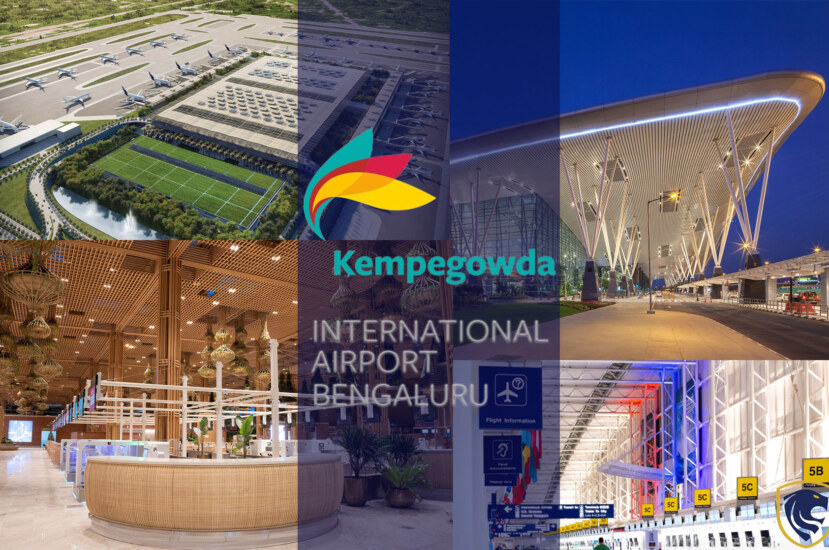The key international entry point into the Indian city of Bangalore (Bengaluru) and the state of Karnataka is Bangalore Kempegowda International Airport.
Skytrax named it the “Best Regional Airport in Central Asia” in 2015. Moreover, the “Best Emerging,” “Best Managed,” and LEED Gold prizes for environmental concerns are among the many honors granted to this international airport.
Bangalore Airport Terminal 1, the only passenger terminal at BKIA Airport, serves both local and international flights and can accommodate more than 20 million people annually. This airport started functioning in May 2008 as a replacement for the HAL Airport. It bears Kempe Gowda I name, who founded Bangalore. Further, this airport is d Designed by CleanMax Solar. Kempegowda International Airport became the state of Karnataka’s first entirely solar-powered airport. Kempegowda International Airport is the 29th busiest airport in Asia. Also, it has ranked third in terms of passenger traffic and air traffic movements. Moreover, it includes domestic cargo handled, and total cargo handled in India. The airport handled about 16.2 million visitors and 411,550 tonnes of cargo in the fiscal years 2021–22.
Why was an airport needed in Bangalore?
HAL originally started operating domestically in the late 1970s after being founded in 1942 for military and defense objectives. Unexpectedly popular new domestic flight options boosted the airport’s quick growth. The initial international flights of this airport began in the late 1990s.

Why was an airport needed in Bangalore?
With flights to Singapore, Air India was the first airline to offer international service. Royal Nepal Airlines, the first foreign airline, began flying from HAL Airport to Kathmandu in 2000. Also, a year later, Lufthansa’s A340 from Germany began flying there. Moreover, there were already several other significant international carriers, including British Airways and Air France.
Nevertheless, with only one runway and a small amount of aircraft parking space, HAL Airport was unable to handle the additional traffic as Bangalore developed into the Silicon Valley of India. More than double its initial capacity of 3.6 million passengers, it received 8 million footfalls in 2007. The airport runway could only accommodate six aircraft, and there was no possibility of further growth. Therefore, a panel was assigned to choose the location of a new airport in March 1991. Devanahalli, a hamlet located around 30 kilometers north of Bangalore, was chosen by the panel. Ultimately, in 1995, the Airports Authority of India (AAI) and the Government of Karnataka decided to issue a request for proposals to foreign consortia to own, construct, and run the city’s new Greenfield airport.
Construction

Construction
On July 2, 2005, construction formally got underway. While a survey predicted the airport would draw 6.7 million visitors in 2008, the airport was adjusted from its initial capacity of 4.5 million people to 11 million, with the terminal area being quadrupled and the number of aircraft platforms increasing. The airport now costs 19.3 billion yen (US$240 million). BIAL scheduled the launch date of 30 March 2008 after 32 months of construction. The debut date was eventually moved to May 11 and May 24, 2008, nevertheless, as a result of delays in setting up air traffic control services at the airport.
BIAL Project
BIAL predicted that traffic would reach 5 million in the project’s first year of operation. Nonetheless, HAL Airport had already served more than 8 million travelers by the time work on the new greenfield airport began. The process redesign and obtaining the required permits took more than nine months, and by the time the enhanced project approval was granted, construction was already halfway complete. Despite the difficulty, the project remained on schedule and was planned to be completed by the original open date.

BIAL Project
The updated enhanced capacity project was built to accommodate eleven million passengers annually. A terminal with eight passenger boarding bridges, a double-arm aerobridge and nine remote bus gates was suggested by the plan. Moreover, it included a runway spanning 4,000 meters with effective taxiways. In addition, BIAL intended to construct an air- and land-side road network. The total project’s anticipated cost was Rs 1,930 crore, or around $430 million.
Levels and Terminals
Terminal 1 at Bangalore Airport has four floors and offers both domestic and international services. Arrivals at the street level are handled at the ground level. Domestic and international check-in halls are located to the left, and domestic and international arrivals are located to the right. International arrivals are done through the Green Channel. Moreover, this area includes duty-free shopping and a café.
The red channel consists of stores, food & beverage, and domestic arrivals. The first level is the Departures Level. The domestic departures are on the left, while the international departures are on the right. Moreover, it has VIP lounges, domestic and international Plaza Premium Lounges, and domestic and international departure lounges.

Bangalore international airport.
Additional facilities and services include seven emigration checkpoints, a customs and international security checkpoint, various duty-free shops, food and beverage options, and The New Day Hotel.
Also, there is a dedicated terminal for Hajj pilgrims that can accommodate approximately 600 people at once. There are prayer rooms available in its amenities.
Lounges
BLR Domestic Lounge is a lounge in the airport that is open all the time. Quality meals, snacks, Wi-Fi, flight monitors, and a smoking area are all available as services in this lounge.
In contrast, alcoholic beverages, conference rooms, printers, and copiers are among the services that may be purchased.

Lounges
BLR International Lounge: Conveniently located next to a smoking area. open all the time. Quality cuisine, snacks, Wi-Fi, flight monitors, newspapers, magazines, TV, internet terminals, and telephones are all available services.
Air India Maharajah Lounge:
This Lounge is open until the final departure at 4:30 am. Amenities include snacks, WiFi, magazines, newspapers, TV, and internet services. Please be aware that the facility is smoke-free.
Cargo facilities
There are three cargo terminals at Kempegowda Airport. One is run by AISATS (Air India Singapore Airport Terminal Services) Ltd. And it contains a storage facility for medicines. In May 2008, the 170,000-square-foot freight terminal opened for business. The terminal has a yearly cargo handling capability of 280,000 tons.

Cargo facilities
Shops in Bangalore international airport
There are lots of shops in this airport where you can buy anything. Shoppers Stop, Shoppers Stop, Duty-Free, Accessories, and Fabindia Store are some of those stores. Moreover, it includes Ode Spa Bangalore airport, CaratLane, Forest Essentials Luxurious Ayurveda, and Relay.

Shops in Bangalore international airport




